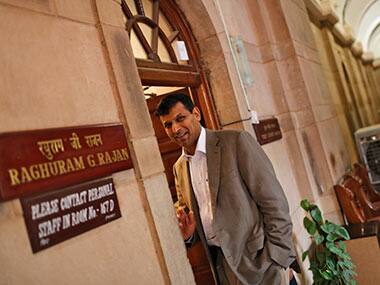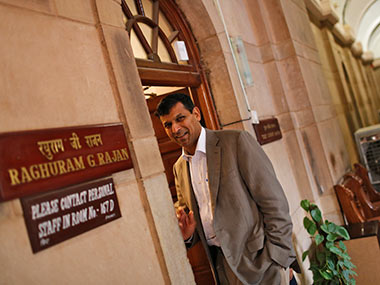The gradual shift of power from the Reserve Bank of India (RBI) to the government in charting the course of monetary policy is more evident from the surprise rate cut by Raghuram Rajan on Wednesday morning, when the apex bank slashed the repo rate, the rate at which it lends to banks, by a quarter percentage points to 7.5 percent. One gets the impression that, unlike the January rate cut, this time the rate action from Rajan was a half-hearted move. The triggers that might have prompted the premature rate cut would have emerged from the North block than Mint Street, if one looks at the fine details of the rate action and Rajan’s policy statement. [caption id=“attachment_2137289” align=“alignleft” width=“380”]
 Reuters[/caption] Evidently, the sharp deterioration in economic growth on the ground, something in sharp contrast to the growth picture the government statisticians’ attempt to portray in the re-based GDP numbers, has more influence on this rate cut, rather than possible comfort within the central bank on a permanent victory over inflation. Rajan, who has been stubborn in his stance of keeping the interest rates high until the time the battle on inflation is completely over, has somewhat relaxed that stance on inflation in the recent months to give room for a relaxed monetary policy, arguably to support the faltering growth. Remember, growth is a bigger concern for the government, unlike the central bank, which has argued in the past that inflation needs to be tackled first, even at the cost of sacrificing growth in the short term in the larger interest of long-term sustainable economic growth. Some economists have warned that the danger of inflation isn’t over yet. Price worries can very well return to the economy if certain risk factors are resurrected. If one takes a closer look at Wednesday’s monetary policy statement, there are sufficient reasons to believe that Rajan himself isn’t confident over a complete victory on inflation. He lists the risk factors. Statement one: “Oil prices have firmed up in recent weeks, and significant further strengthening, perhaps as a result of unanticipated geo-political events, will alter the inflation outlook”. Two: “Food prices will be affected by the seasonal upturn that typically occurs ahead of the south-west monsoon and, therefore, steps the government takes on food management will be critical in determining the inflation outlook.” Third: “The possible spill over of volatility from international financial markets through exchange rate and asset prices channels is also still a significant risk”. Fourth: “In the short run, however, the postponement of fiscal consolidation to the 3 per cent target by one year will add to aggregate demand. At a time of accelerating economic recovery, this is, prima facie, a source for concern from the standpoint of aggregate demand management, especially with large borrowings intended for public sector enterprises”. On the other hand, Rajan has left enough hints to say that the RBI isn’t confident about India’s high growth numbers depicted by the re-based GDP growth numbers, released recently, which forecasts India to grow by 7.4 per cent in fiscal year 2015, becoming the world’s fastest growing major economy, matching the growth of its illustrious neighbour, China. Such a growth can be a reality only if supported by a 6.8 percent growth in the manufacturing sector, whereas the actual growth data available so far show that this segment can’t grow more than more than 2.5 percent this fiscal year. Similar is the case with financial sector. Almost everyone, including the RBI governor and the government’s own economic advisor, both of them well-known economists themselves, don’t seem to be convinced with such a magical growth numbers far different from the reality. As Firstpost has
noted before
, the fresh GDP numbers aren’t anyway supported by any of the critical components of growth such as credit growth, stressed asset situation, auto sales, manufacturing growth and growth in the financial sector. There is a huge disconnect. Rajan has openly expressed his lack of confidence in the fresh GDP estimates and reduced rates to support the slow growth, which is the reality. He says: “The picture it (the new GDP estimates) presents of a robust economy, with growth having picked up significantly over the last three years, is at odds with still-low direct measures of growth of production, credit, imports and capacity utilisation as well as with anecdotal evidence on the state of the economic cycle. Nevertheless, the picture of a steadily recovering economy appears right." Also, according to the new monetary policy framework, the inflation should be in a band of 2-6 percent with a target of 4 percent by 2016-17. Given the risk factors Rajan himself has elaborated, a 5.1 percent retail inflation recorded in January is dangerously close to the upper limit, unless the February numbers offer a sharp fall, and wouldn’t have given Rajan the comfort to cut rates, in normal course. Rajan would have waited for a few months of inflation numbers to make up his mind in inflation trajectory and loose the grip on interest rates, after such a prolonged fight on inflation. Instead, he opted for what appeared like a hurried, unscheduled, rate cut. The short message is this: The recently signed new monetary policy framework, under which RBI is one of the stakeholders along with government, is already in force. As Firstpost noted on the budget day, the framework has cut down powers of the central bank in charting the course of monetary policy, as we have seen it. There is an equal, if not, bigger, say for the North block in the new scheme of things. There is more than meets the eye in the untimely rate cut by the central bank.
Reuters[/caption] Evidently, the sharp deterioration in economic growth on the ground, something in sharp contrast to the growth picture the government statisticians’ attempt to portray in the re-based GDP numbers, has more influence on this rate cut, rather than possible comfort within the central bank on a permanent victory over inflation. Rajan, who has been stubborn in his stance of keeping the interest rates high until the time the battle on inflation is completely over, has somewhat relaxed that stance on inflation in the recent months to give room for a relaxed monetary policy, arguably to support the faltering growth. Remember, growth is a bigger concern for the government, unlike the central bank, which has argued in the past that inflation needs to be tackled first, even at the cost of sacrificing growth in the short term in the larger interest of long-term sustainable economic growth. Some economists have warned that the danger of inflation isn’t over yet. Price worries can very well return to the economy if certain risk factors are resurrected. If one takes a closer look at Wednesday’s monetary policy statement, there are sufficient reasons to believe that Rajan himself isn’t confident over a complete victory on inflation. He lists the risk factors. Statement one: “Oil prices have firmed up in recent weeks, and significant further strengthening, perhaps as a result of unanticipated geo-political events, will alter the inflation outlook”. Two: “Food prices will be affected by the seasonal upturn that typically occurs ahead of the south-west monsoon and, therefore, steps the government takes on food management will be critical in determining the inflation outlook.” Third: “The possible spill over of volatility from international financial markets through exchange rate and asset prices channels is also still a significant risk”. Fourth: “In the short run, however, the postponement of fiscal consolidation to the 3 per cent target by one year will add to aggregate demand. At a time of accelerating economic recovery, this is, prima facie, a source for concern from the standpoint of aggregate demand management, especially with large borrowings intended for public sector enterprises”. On the other hand, Rajan has left enough hints to say that the RBI isn’t confident about India’s high growth numbers depicted by the re-based GDP growth numbers, released recently, which forecasts India to grow by 7.4 per cent in fiscal year 2015, becoming the world’s fastest growing major economy, matching the growth of its illustrious neighbour, China. Such a growth can be a reality only if supported by a 6.8 percent growth in the manufacturing sector, whereas the actual growth data available so far show that this segment can’t grow more than more than 2.5 percent this fiscal year. Similar is the case with financial sector. Almost everyone, including the RBI governor and the government’s own economic advisor, both of them well-known economists themselves, don’t seem to be convinced with such a magical growth numbers far different from the reality. As Firstpost has
noted before
, the fresh GDP numbers aren’t anyway supported by any of the critical components of growth such as credit growth, stressed asset situation, auto sales, manufacturing growth and growth in the financial sector. There is a huge disconnect. Rajan has openly expressed his lack of confidence in the fresh GDP estimates and reduced rates to support the slow growth, which is the reality. He says: “The picture it (the new GDP estimates) presents of a robust economy, with growth having picked up significantly over the last three years, is at odds with still-low direct measures of growth of production, credit, imports and capacity utilisation as well as with anecdotal evidence on the state of the economic cycle. Nevertheless, the picture of a steadily recovering economy appears right." Also, according to the new monetary policy framework, the inflation should be in a band of 2-6 percent with a target of 4 percent by 2016-17. Given the risk factors Rajan himself has elaborated, a 5.1 percent retail inflation recorded in January is dangerously close to the upper limit, unless the February numbers offer a sharp fall, and wouldn’t have given Rajan the comfort to cut rates, in normal course. Rajan would have waited for a few months of inflation numbers to make up his mind in inflation trajectory and loose the grip on interest rates, after such a prolonged fight on inflation. Instead, he opted for what appeared like a hurried, unscheduled, rate cut. The short message is this: The recently signed new monetary policy framework, under which RBI is one of the stakeholders along with government, is already in force. As Firstpost noted on the budget day, the framework has cut down powers of the central bank in charting the course of monetary policy, as we have seen it. There is an equal, if not, bigger, say for the North block in the new scheme of things. There is more than meets the eye in the untimely rate cut by the central bank.
Real reason behind rate cut: Govt's growth concern trumps RBI's inflation worry
Dinesh Unnikrishnan
• March 5, 2015, 11:00:33 IST
There is more than meets the eye in the untimely rate cut by the central bank
Advertisement
)
End of Article